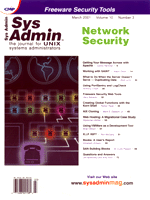 Books:
A User's Report Books:
A User's Report
Elizabeth Zinkann
Examples, integration, and certification are the keywords to describe
this month's column and the reviews. I've included reviews
of an entire book of examples, a book that describes integration
procedures, and a certification guide for HP-UX. The specific reviews
include: Java Examples in a Nutshell, Second Edition by David
Flanagan (O'Reilly & Associates, Inc.); Integrate Linux
Solutions into Your Windows Network by Dustin Puryear (Prima
Tech); and HP Certified: HP-UX System Administration by Rafeeq
Ur Rehman (Hewlett-Packard Professional Books, Prentice Hall).
Java Examples in a Nutshell
Second Edition
David Flanagan
O'Reilly & Associates, Inc.
ISBN 0-596-00039-1
566 Pages
$29.95
http://www.oreilly.com/
One of the most effective ways to learn a new skill, whether it
is the design and creation of a stained glass window or of a computer
program, is through the use of examples. This reliable method demonstrates
the processes to use and factors to consider during each phase.
Following an example is a prelude to independently utilizing any
newly acquired craft or knowledge. In Java Examples in a Nutshell,
author David Flanagan devotes an entire book to different types
of examples using Java. The original edition was created as a supplement
to the Java in a Nutshell book. The second edition, also
subtitled A Tutorial Companion to Java in a Nutshell, presents
updated examples for Java 2, Version 1.3. Flanagan also included
some new chapters and has reorganized and expanded the existing
material.
The second edition features three major sections: Core Java APIs,
Graphics and GUIs, and Enterprise Java. The initial part, Core Java
APIs, addresses the fundamental topics in the following order: Java
Basics; Objects, Classes, and Interfaces; Input/Output; Threads;
Networking; Security and Cryptography; Internationalization; Reflection;
and Object Serialization. In Part II: Graphics and GUIs, the author
provides examples and exercises relating to: Graphical User Interfaces,
Graphics, Printing, Data Transfer, Java Beans, and Applets. Enterprise
Java features Remote Method Invocation, Database Access with SQL,
Servlets and JSP, XML, and an Example Index. The Example Index Chapter,
the XML chapter (also available online at http://www.oreilly.com/catalog/jenut2/chapter/chap19.html),
and The Servlets and JSP chapter are new additions.
Java Examples in a Nutshell actually complements three
books: Java in a Nutshell, Java Foundation Classes in
a Nutshell, and Java Enterprise in a Nutshell. Flanagan
introduces the topic or topics within each chapter, provides essential
information about them, illustrates how to implement the concepts
through programming examples, and concludes each chapter with exercises.
(The examples can also be accessed online to reduce both typing
time and errors.) Java Examples in a Nutshell features useful
examples, from filtering lines of text or character streams to a
clock applet and image processing. This is an excellent book and
a superb learning aid for Java programmers at every level.
Integrate Linux Solutions into Your Windows Network
Dustin Puryear
Prima Tech
ISBN 0-7615-2791-5
803 Pages
$49.99
http://www.prima-tech.com/
Today's networks may employ a diverse collection of computers
and operating systems. One or more computers running Linux, UNIX,
Windows, Novell, and Macintosh are often combined within a single
network structure. The systems administrator's job is to seamlessly
integrate the different platforms for printing, sharing peripherals,
and sharing files with optimum performance and a minimum of user
inconvenience. (That's why administrators are also known as
magicians.) In Integrate Linux Solutions into Your Windows Networks,
author/administrator/magician Dustin Puryear examines the concepts
and implementations related to maintaining multiple platforms within
a network. Although Puryear specifically addresses Linux and the
Windows environment, he also describes each topic in general terms,
so that the discussions are also applicable to non-Windows systems.
The author approaches the various aspects of integration through
four sections: Part I: Knowing, Using, and Configuring Linux; Part
II: File and Print Services; Part III: Networking and Security Services;
and Part IV: Databases and Dynamic Web Sites. The Appendix contains
the GNU General Public License. Part I: Knowing Using, and Configuring
Linux includes Getting to Know Linux, Using Linux, and Understanding
Linux Administration. (Puryear does not include specific installation
instructions; they will differ depending on the selected distribution.)
The information provided in these chapters could easily comprise
a smaller book on configuration options. The author presents bottom-line
analyses of computer hardware plus operating systems comparisons,
noting their strengths and weaknesses. He also describes the components
of the Linux operating system, encompassing the file system, memory
and process control, and TCP/IP services and networking. Puryear
details and demonstrates BASH (the Bourne Again Shell) programming
and techniques plus the fundamentals of Linux systems administration.
Part II: File and Print Services discusses Samba installation,
configuration, features, and use through: Integrating Windows and
Linux SMB/CIFS Services Using Samba; Using Samba for Windows Access
Control, Files, and Printers; and Introducing Advanced Samba Services
and Techniques. Puryear explains the Samba essentials plus some
of its more advanced capabilities and troubleshooting methods. In
Part III: Networking and Security Services, the author describes
Securing Your Network with Linux, Enabling Secure Remote Access
and PPP Networking, and Offering Electronic Mail and Directory Services.
Through the content in these chapters, the reader easily progresses
from good security practices to firewall construction, secure remote
access using OpenSSH, electronic mail basics and configurations,
and Directory Services. In the final section, Part IV: Databases
and Dynamic Web Sites, the author explores Serving Up Databases
with MySQL, Offering Web Services, and Creating Web-Based Applications
and Dynamic Sites. Puryear outlines MySQL installation and administration
procedures and demonstrates how to create and modify MySQL databases.
In the Offering Web Services chapter, the author discusses the installation,
configuration, and features of the Apache Web Server. He also creates
a sample server configuration and presents some useful tools. The
final chapter introduces PHP and explains how to use it plus how
to combine PHP and MySQL for a Web site.
Integrate Linux Solutions into Your Windows Network by
Dustin Puryear is a superb book. The author presents each topic's
concepts, describes how it works, and shows how to implement it
through a step-by-step procedure. The contents of the book are wonderfully
complete, covering almost every topic that an administrator could
possibly need. Puryear augments his straightforward textual descriptions
with numerous notes, diagrams, figures, tables, and examples. The
result is an excellent book and reference for anyone integrating
systems, contemplating integration, or curious about how different
platforms can work together.
HP Certified
HP-UX System Administration
Rafeeq Ur Rehman
Hewlett-Packard Professional Books
Prentice Hall
ISBN 0-13-018374-1
789 Pages
$59.99
http://www.phptr.com/
The quest for system certifications continues to be a popular
education option. Whether the system is Solaris, Linux, or HP-UX,
certification can be a quick way to convey familiarity and knowledge
of a system. Additionally, most certification books (ignoring the
questions and sample quizzes designed to help anyone gain certification)
provide excellent resources and references for routine tasks. In
HP Certified, Rehman has compiled and organized the information
required for Hewlett-Packard's three part System Administration
exam (3H0-002). He presents the topics covered by the tests, describes
what they entail and how they work, and structures each chapter
to conclude with a chapter summary, chapter review questions, and
sample test questions entitled Test Your Knowledge. The Preface
also includes How to Register for the HP-UX Certification Examination
and Strategies for Taking the Test. The author approaches the different
aspects covered by the examinations through three major sections:
Part I: Fundamentals of UNIX Systems, Part II: HP-UX System Administration,
and Part III: HP-UX Network Administration.
The first section discusses basic UNIX concepts and procedures.
The individual chapters detail: Getting Started with UNIX, Working
with Files and Directories, Environment Variables, Input/Output
Redirection and Pipes, Using the vi Editor, Regular Expressions,
File Permissions, UNIX File System Hierarchy, Working with the POSIX
Shell and Job Control, Introduction to Shell Programming, and Advanced
Shell Programming. The second section, Part II: HP-UX System Administration,
examines the processes specific to systems administration and HP-UX
systems through the following chapters: The System Administration
Manager (SAM), Installing HP-UX, System Startup and Shutdown, Software
and Patch Management, Reconfiguring the HP-UX Kernel, Peripheral
Devices, HP-UX File Systems and Logical Volume Manager (LVM), User
and Group Management, Dealing with HP-UX Processes, Printing on
HP-UX, Memory and Swap Space Management, System Backup and Recovery,
Automating Jobs, and System Performance Monitoring. Although all
three sections of the book are important, this is the most HP-UX-intensive
section. Rehman not only addresses the greatest number of topics,
but he also explains the subjects that are unique in some way to
HP-UX.
Part III: HP-UX Network Administration, analyzes networking fundamentals,
theories, and implementations through: Basic Network Concepts, Network
Components and Topologies, Introduction to the TCP/IP Protocol,
Configuring LAN Interface Adapters, Configuring and Managing ARPA/Berkeley
Services, Host Name Resolution and Domain Name Server, Configuring
and Managing NIS, Configuring and Managing the Network File System,
HP-UX Automounter, Network Time Protocol, and System and Network
Administration: Final Thoughts. The Appendices contain: A) Chapter
Review Answers, B) Test Your Knowledge Answers, C) HP-UX Command
and Configuration Files, and D) Sample HP-UX Certification Exam.
HP Certified by Rafeeq Ur Rehman provides an important
guide to the HP-UX certification procedures and tests for systems
administration. The author demonstrates the information covered
by each of the three tests and provides test questions and situations
as exercises for the reader. Rehman establishes an excellent study
regimen, with sample questions and tests to ensure successful certification
results.
Elizabeth Zinkann has been involved in the UNIX and C environment
for the past 15 years. She is currently a UNIX and C consultant,
and one of her specialties is UNIX education. In addition to her
computer science background, she also has a degree in English. Her
writing has also appeared in Linux Magazine, Performance
Computing, and Network Administrator. Elizabeth can be
reached at: elizabeth@equillink.com.
|

